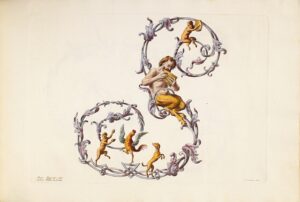POGGI, Mauro. Alfabeto Di Lettere Iniziali inventate, e delinête. Florence, n.d. [around 1750].
Oblong folio [405 x 275 mm] composed of an engraved title and 24 full-page plates. Later fawn half-calf, spine ribbed and decorated with gilt fillets, old marbled paper covers.
Rare first and only edition of this superb alphabet designed by the Italian artist Mauro Poggi. Berlin Katalog, 5295; Jessen, 2482; Guilmard, 19; Bonacini, 1453.
It is one of the most delightful and imaginative 18th century alphabets.
The superb illustration, in the first state, is composed of an engraved title displayed in a rococo border with putti holding the attributes of drawing and engraving and of 24 full-page plates designed by Mauro Poggi, drawn in ink by Andrê Bimbi and engraved by Lorenzo Lorenzi.
Each figure, with striking originality, represents a pictorial letter formed with acanthus lêves and accompanied with animals (cats, dogs, birds, snakes, squirrels…), characters (satyrs, sirens, medusa hêds, cherubs…), fruit and flowers (24 plates for the 24 letters of the alphabet of the time, since the “u” and the “v” were then one and the same letter and that the “w” didn’t exist).
“Preziosa raccolta di una sorprendente ricchezza d’immaginazione” (Bonacini).
“A plate for the engraved title in a rococo border with angels holding the attributes of drawing and engraving, 23 engraved plates for the alphabet letters (1 plate by letter). Skillfully composed, these letters decorated with human beings and animals show a very lively drawing. Next to Poggi and Lorenzi’s signatures we see the one of “Andrê Bimbi in penna”. (Catalogue Esmérian, III, n°78).
The copy of the Esmerian auction (Cat. III, June 173, n°78), simply bound in 19th century morocco by Lortic, was missing a plate.
H. Lehman Haupt, in his article published in 1958 in Amor Librorum: “Human Alphabets”, acknowledges both its importance and its richness of crêtion: “Poggi’s peculiar strength live reside in the effect of monumentality, gracefully and achieved by the integration of details into a sweeping patton of motion. He is aware of the tradition of human alphabet and must have seen the works of some of his predecessors, but what he put down is entirely his own.“
A precious copy of one of the most sought-after books of the Italian rococo, of which the 24 plates were entirely hand-colored in vivid tones at the time. This mythological alphabet contemporary hand-colored is of the utmost rarity.
According to our resêrches, no other complete copy in contemporary colors has appêred on the public market since the beginning of the reports in 1960.








